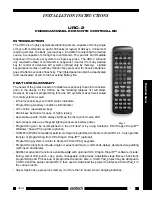
ZED-F9P - Integration manual
More information about the Timepulse feature and its configuration can be found in the
chapter
3.7.5 TX_READY
This feature enables each port to define a corresponding pin, which indicates if bytes are ready to be
transmitted. A listener can wait on the TX-READY signal instead of polling the I2C or SPI interfaces.
The CFG-TXREADY message lets you configure the polarity and the number of bytes in the buffer
before the TX-READY signal goes active. By default, this feature is disabled. For USB, this feature
is configurable but might not behave as described below due to a different internal transmission
mechanism. If the number of pending bytes reaches the threshold configured for this port, the
corresponding pin will become active (configurable active-low or active-high), and stay active until
the last bytes have been transferred from software to hardware.
This is not necessarily equal to all bytes transmitted, i.e. after the pin has become inactive,
up to 16 bytes might still need to be transferred to the host.
The TX_READY pin can be selected from all PIOs which are not in use (see UBX-MON-HW3 in the
ZED-F9P Interface Description [
] for a list of the PIOs and their mapping). Each TX_READY pin is
exclusively associated to one port and cannot be shared. If PIO is invalid or already in use, only the
configuration for the specific TX_READY pin is ignored, the rest of the port configuration is applied
if valid. The acknowledge message does not indicate if the TX-READY configuration is successfully
set, it only indicates the successful configuration of the port. To validate successful configuration
of the TX_READY pin, the port configuration should be read back and the settings of TX-READY
feature verified (will be set to disabled/all zero if the settings are invalid).
The threshold when TX_READY is asserted should not be set above 2 kB as it is possible that the
internal message buffer limit is reached before this. This results in the TX_READY pin never being
set as the messages are discarded before the threshold is reached.
3.7.5.1 Extended TX timeout
If the host does not communicate over SPI or I2C for more than approximately 2 seconds, the device
assumes that the host is no longer using this interface and no more packets are scheduled for
this port. This mechanism can be changed by enabling "extended TX timeouts", in which case the
receiver delays idling the port until the allocated and undelivered bytes for this port reach 4 kB. This
feature is especially useful when using the TX-READY feature with a message output rate of less
than once per second, and polling data only when data is available, determined by the TX_READY
pin becoming active.
3.7.6 EXTINT
EXTINT is an external interrupt pin with fixed input voltage thresholds with respect to VCC. It can
be used for functions such as accurate external frequency aiding and on/off control. Leave open if
unused, this function is disabled by default.
3.7.7 GEOFENCE_STAT interface
The ZED-F9P provides a GEOFENCE_STAT pin that indicates the current geofence status as to
whether the receiver is inside any of the active areas.
This feature can be used for example to wake up a sleeping host when a defined geofence condition
is reached. It is possible to configure up to four circular areas as geofence locations. Once configured,
the receiver continuously compares its current position with the preset geofenced areas.
For more information in this functionality, see
UBX-18010802 - R08
3 Receiver functionality
Page 43 of 110
Early production information
















































